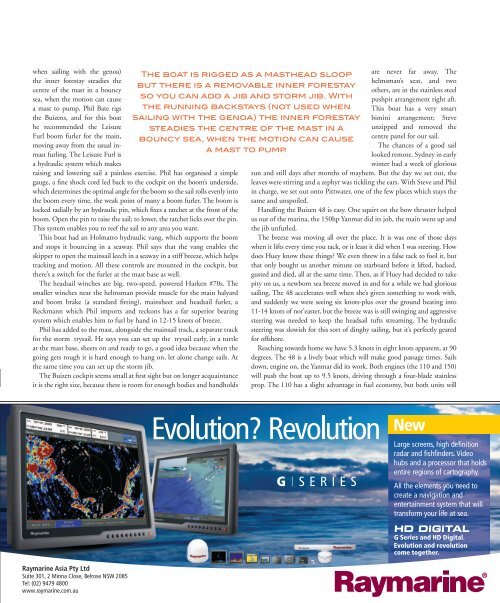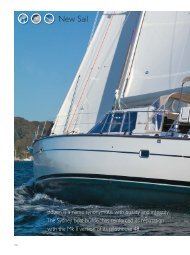reading this article - Buizen Yachts
reading this article - Buizen Yachts
reading this article - Buizen Yachts
You also want an ePaper? Increase the reach of your titles
YUMPU automatically turns print PDFs into web optimized ePapers that Google loves.
when sailing with the genoa)<br />
the inner forestay steadies the<br />
centre of the mast in a bouncy<br />
sea, when the motion can cause<br />
a mast to pump. Phil Bate rigs<br />
the <strong>Buizen</strong>s, and for <strong>this</strong> boat<br />
he recommended the Leisure<br />
Furl boom furler for the main,<br />
moving away from the usual inmast<br />
furling. The Leisure Furl is<br />
a hydraulic system which makes<br />
raising and lowering sail a painless exercise. Phil has organised a simple<br />
gauge, a fine shock cord led back to the cockpit on the boom’s underside,<br />
which determines the optimal angle for the boom so the sail rolls evenly into<br />
the boom every time, the weak point of many a boom furler. The boom is<br />
locked radially by an hydraulic pin, which fixes a ratchet at the front of the<br />
boom. Open the pin to raise the sail; to lower, the ratchet licks over the pin.<br />
This system enables you to reef the sail to any area you want.<br />
This boat had an Holmatro hydraulic vang, which supports the boom<br />
and stops it bouncing in a seaway. Phil says that the vang enables the<br />
skipper to open the mainsail leech in a seaway in a stiff breeze, which helps<br />
tracking and motion. All these controls are mounted in the cockpit, but<br />
there’s a switch for the furler at the mast base as well.<br />
The headsail winches are big, two-speed, powered Harken #70s. The<br />
smaller winches near the helmsman provide muscle for the main halyard<br />
and boom brake (a standard fitting), mainsheet and headsail furler, a<br />
Reckmann which Phil imports and reckons has a far superior bearing<br />
system which enables him to furl by hand in 12-15 knots of breeze.<br />
Phil has added to the mast, alongside the mainsail track, a separate track<br />
for the storm trysail. He says you can set up the trysail early, in a turtle<br />
at the mast base, sheets on and ready to go, a good idea because when the<br />
going gets rough it is hard enough to hang on, let alone change sails. At<br />
the same time you can set up the storm jib.<br />
The <strong>Buizen</strong> cockpit seems small at first sight but on longer acquaintance<br />
it is the right size, because there is room for enough bodies and handholds<br />
are never far away. The<br />
helmsman’s seat, and two<br />
others, are in the stainless steel<br />
pushpit arrangement right aft.<br />
This boat has a very smart<br />
bimini arrangement; Steve<br />
unzipped and removed the<br />
centre panel for our sail.<br />
The chances of a good sail<br />
looked remote. Sydney in early<br />
winter had a week of glorious<br />
sun and still days after months of mayhem. But the day we set out, the<br />
leaves were stirring and a zephyr was tickling the ears. With Steve and Phil<br />
in charge, we set out onto Pittwater, one of the few places which stays the<br />
same and unspoiled.<br />
Handling the <strong>Buizen</strong> 48 is easy. One squirt on the bow thruster helped<br />
us out of the marina, the 150hp Yanmar did its job, the main went up and<br />
the jib unfurled.<br />
The breeze was moving all over the place. It is was one of those days<br />
when it lifts every time you tack, or it least it did when I was steering. How<br />
does Huey know these things We even threw in a false tack to fool it, but<br />
that only bought us another minute on starboard before it lifted, backed,<br />
gusted and died, all at the same time. Then, as if Huey had decided to take<br />
pity on us, a newborn sea breeze moved in and for a while we had glorious<br />
sailing. The 48 accelerates well when she’s given something to work with,<br />
and suddenly we were seeing six knots-plus over the ground beating into<br />
11-14 knots of nor’easter, but the breeze was is still swinging and aggressive<br />
steering was needed to keep the headsail tufts streaming. The hydraulic<br />
steering was slowish for <strong>this</strong> sort of dinghy sailing, but it’s perfectly geared<br />
for offshore.<br />
Reaching towards home we have 5.3 knots in eight knots apparent, at 90<br />
degrees. The 48 is a lively boat which will make good passage times. Sails<br />
down, engine on, the Yanmar did its work. Both engines (the 110 and 150)<br />
will push the boat up to 9.5 knots, driving through a four-blade stainless<br />
prop. The 110 has a slight advantage in fuel economy, but both units will<br />
The boat is rigged as a masthead sloop<br />
but there is a removable inner forestay<br />
so you can add a jib and storm jib. With<br />
the running backstays (not used when<br />
sailing with the genoa) the inner forestay<br />
steadies the centre of the mast in a<br />
bouncy sea, when the motion can cause<br />
a mast to pump.




